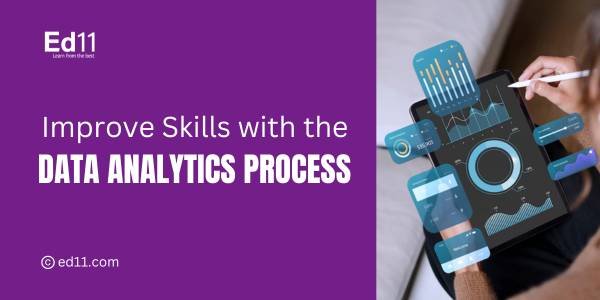Improve Skills with the Data Analytics Process
Boost your data skills with the data analytics process. Learn key steps like goal setting, data collection, and analysis to grow your expertise.

To improve your skills and become an expert in data analysis, understanding the data analytics process is essential. This process involves collecting, cleaning, analyzing, and interpreting data to uncover valuable insights. By following a structured approach, you can identify trends, solve problems, and support data-driven decisions. The Data Analytics Process helps ensure that the information you work with is accurate and meaningful. Whether you're analyzing sales, customer feedback, or market trends, using this process effectively will lead to better outcomes. Practice regularly, and you’ll see improvements in your ability to handle and understand data.
What Is the Data Analytics Process
The data analytics process is a step-by-step method that helps businesses make sense of data. It starts by collecting raw data from different sources, followed by cleaning it to remove errors or duplicates. Next, the data is analyzed to find patterns, trends, and useful insights. Once the analysis is complete, the results are interpreted and used to guide decisions. This process is important because it turns large amounts of information into valuable knowledge. The data analytics process helps companies solve problems, improve efficiency, and predict future trends, making it an essential tool for success.
Importance of Data Analytics Process
Data is everywhere in today’s world, and businesses rely on it to make decisions. The data analytics process is essential because it helps organizations gain valuable insights, improve efficiency, and make better decisions. Let’s explore why this process is important.
-
Turning Raw Data into Useful Insights: Raw data on its own is often messy and difficult to understand. The data analytics process cleans, organizes, and analyzes this data to reveal patterns, trends, and relationships. This allows companies to make informed decisions based on facts rather than guesses.
-
Improving Business Performance: Companies can use data analytics to identify areas for improvement. For example, analyzing customer feedback and sales data can help businesses improve their products or services. By understanding what works and what doesn’t, businesses can increase efficiency and reduce costs.
-
Helping with Decision-Making: Data analytics provides evidence-based recommendations. When businesses need to make important decisions, having data-backed insights ensures that choices are based on solid information. This reduces risks and improves the chances of success.
-
Predicting Future Trends: Through techniques like predictive analytics, companies can forecast future events and market trends. For example, analyzing past customer behavior helps predict future purchases. This allows businesses to prepare for upcoming opportunities or challenges.
-
Enhancing Customer Experience: Analyzing customer data can reveal preferences, pain points, and behaviors. Companies can use this information to personalize services, improve customer satisfaction, and build stronger relationships with their clients.
Key Steps in the Data Analytics Process
The data analytics process involves several key steps that help transform raw data into useful information. It is an essential part of Data Science, which focuses on gathering, analyzing, and interpreting data for decision-making.
Define Your Goal
Every project starts with a clear objective. Ask yourself, what problem do you want to solve? What questions should the data answer? Setting clear goals keeps you focused throughout the data analytics process. Without proper objectives, analyzing data may lead to confusion or incorrect conclusions. A key part of data analytics is using the right Programming Language. Popular ones like Python, R, and SQL are widely used to clean, analyze, and visualize data. Python is especially loved for its simplicity and powerful libraries. Choosing the right programming language makes it easier to handle large datasets and perform complex tasks efficiently. Additionally, having clear objectives helps you decide which programming language tools to use for specific tasks. For example, SQL is best for managing databases, while Python is ideal for machine learning models. With a clear purpose and the right tools, you can generate meaningful insights and solve real-world problems effectively.
Example: If you’re analyzing customer data, your goal might be to find out why sales dropped last month.
Collect the Data
Gathering the right data is a key part of the data analytics process. If you collect data that doesn’t relate to your goals, the results will be misleading or useless. Relevant data can come from various sources like databases, customer surveys, website interactions, or even external market reports. The data analytics process works best when you focus on data that is accurate, timely, and tied to the specific questions you want to answer. For example, if you’re trying to improve customer satisfaction, collecting feedback and purchase history will give you more useful insights. Without relevant data, businesses risk making poor decisions or missing growth opportunities.
Tip: Don’t gather too much irrelevant information. Focus on quality over quantity to streamline the data analytics process.
Clean and Prepare the Data
Raw data is often messy, with missing or incorrect values, making it hard to analyze. Cleaning the data is an important step to ensure accuracy and reliability. When data is clean, the analysis gives better results, helping businesses make correct decisions. Python is a popular programming language used for data cleaning. Libraries like Pandas and NumPy help identify missing values, fix errors, and remove duplicates. For example, Python can fill empty values with averages or remove unnecessary columns automatically. Without proper cleaning, raw data can lead to wrong conclusions. Python’s flexibility and built-in tools make it easy for data analysts to clean large datasets quickly. By using Python, companies can turn messy data into accurate, useful information.
Tasks include
-
Removing duplicates
-
Handling missing values
-
Correcting errors
This step is one of the most time-consuming parts of the data analytics process but is essential for reliable outcomes.
Analyze the Data
Here’s where the fun begins! The data analytics process becomes exciting when you start using tools like Excel, Python, R, or data visualization software. These tools help transform large amounts of data into visual charts, graphs, and dashboards, making complex data easier to understand. The data analytics process identifies key patterns, trends, and relationships hidden within the data. For example, you can spot which products are selling well, when customers are most active, or which areas of a business need improvement. By analyzing this information, companies can make decisions with confidence and precision. Whether it's predicting customer behavior or improving marketing strategies, the data analytics process ensures that every decision is supported by solid facts. Tools like Python and R make it possible to perform advanced analyses, while Excel and visualization tools present the results in user-friendly formats. In today’s data-driven world, mastering the data analytics process is essential for success.
Analysis techniques
-
Descriptive analysis: Summarize the data to understand the basics.
-
Diagnostic analysis: Look into why something happened.
-
Predictive analysis: Forecast future outcomes based on patterns.
Your ability to analyze data effectively will grow stronger with consistent practice of the data analytics process. As you work through each step, like data collection, analysis, and interpretation, you’ll gain confidence and better insights.
Interpret and Share Results
After analyzing the data, interpreting the results is a crucial step in the data analytics process. You need to explain what the numbers mean and how they impact the business. This involves identifying key takeaways, trends, or issues found during the analysis. Communicating these results to stakeholders is important to ensure everyone understands the insights. Visual tools like charts, graphs, and reports can simplify complex data and make it easier to grasp. For example, if you used SQL to query and gather data, you can show how specific datasets were filtered, combined, or calculated. Stakeholders are more likely to make informed decisions when they see clear and well-organized data visualizations. Whether it’s sales growth, customer trends, or operational efficiency, presenting the results in a simple and concise manner builds trust in the analysis. Always ensure that your SQL-based data queries are accurate to avoid misinterpretation.
Tip: Keep it simple. Non-technical team members appreciate easy-to-read visuals and key takeaways.
Take Action Based on Insights
The final step in the data analytics process is applying the insights to solve problems or make smarter decisions. These insights help businesses improve in different areas, such as adjusting marketing campaigns, enhancing product designs, or streamlining internal operations. For example, if the data shows that a product feature is underperforming, companies can make changes to improve it. Many businesses rely on tools like Tableau to visualize data and share insights with teams. Tableau makes it easy to create clear, interactive dashboards that help decision-makers see patterns and trends quickly. With these visuals, businesses can act faster and ensure that the right adjustments are made to meet goals. Whether it's boosting sales or improving customer satisfaction, applying insights through tools like Tableau leads to better results.
Tools to Master the Data Analytics Process
To improve your skills, you should familiarize yourself with popular data analytics tools. These tools help you work with data efficiently and gain useful insights.
-
Excel: A common tool for organizing and analyzing data using spreadsheets, formulas, and charts. It’s easy to learn and widely used in businesses.
-
SQL: A language used to access and manage data stored in databases. Learning SQL helps you extract valuable information from large datasets.
-
Tableau: A powerful data visualization tool that creates charts, graphs, and dashboards. It helps present complex data in an easy-to-understand way.
-
Power BI: Similar to Tableau, Power BI helps visualize data and create interactive reports. It’s a great tool for businesses of any size.
-
Python and R: Both programming languages are widely used in data analysis. They offer advanced tools to clean, analyze, and model data.
-
Google Analytics: Useful for analyzing website traffic and user behavior. It’s essential for marketers and online businesses.
-
SAS: A tool used for statistical analysis, often in large organizations. It’s great for handling complex data and predictive modeling.
Common Mistakes to Avoid in the Data Analytics Process
Even experienced data analysts can make mistakes, but you can avoid common errors by following these simple tips.
-
Skipping the Cleaning Step: Data can often be messy or incomplete. If you skip cleaning it, the results of your analysis may be incorrect or misleading. Always take time to clean and organize your data.
-
Lack of a Clear Goal: Before analyzing data, set a clear objective. Without knowing what you’re looking for, you may end up wasting time exploring information that doesn’t help your project.
-
Ignoring the Business Context: Even perfectly analyzed data is useless if it doesn’t fit the business’s needs. Always understand the bigger picture and ensure your analysis solves real problems.
How to Continuously Improve
-
Stay Updated: Data analytics is always changing. Learn about the latest tools, methods, and trends to stay relevant and competitive.
-
Practice Regularly: Practice makes perfect. Work on small tasks, case studies, or challenges to sharpen your problem-solving skills.
-
Work on Projects: Applying what you learn is key. Take on real projects or simulations to understand how data analytics works in real-world situations.
-
Learn from Mistakes: Mistakes help you grow. Review where things went wrong and use the lessons to improve your future work.
-
Join Communities: Connect with other data analysts through forums, meetups, or online groups. Sharing knowledge helps you learn faster.
-
Take Online Courses: Many online platforms offer courses on data analytics. They can help you learn at your own pace and gain practical knowledge.
The data analytics process is an essential tool for improving data skills and making better decisions. By following key steps like setting clear goals, gathering data, cleaning it, analyzing the information, and interpreting the results, you can gain valuable insights. These steps help you turn raw information into meaningful outcomes that drive success. As you practice these steps, you’ll gain confidence and become more efficient in handling data projects. With time, you’ll see patterns faster, solve problems easily, and make data-driven decisions. Whether you're a beginner or someone with experience, mastering this process can lead to new opportunities in your career.




















